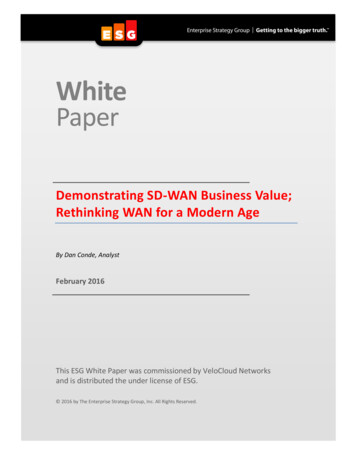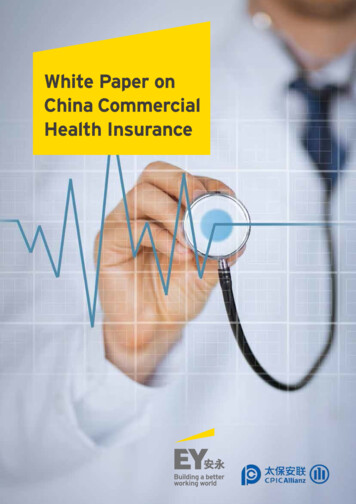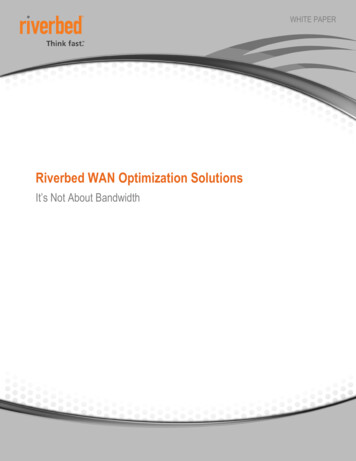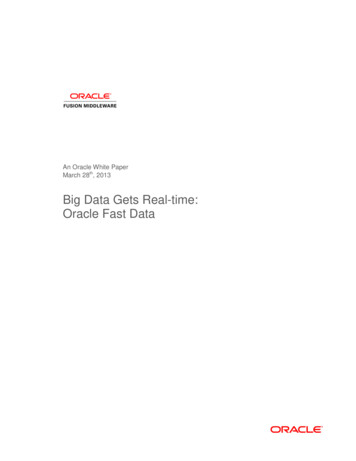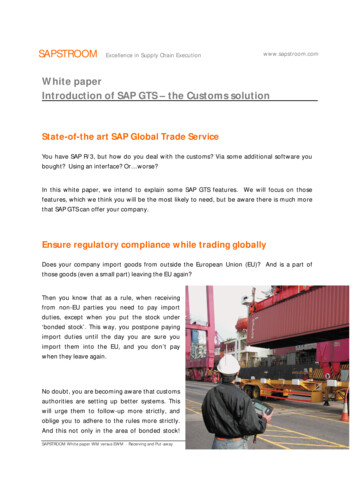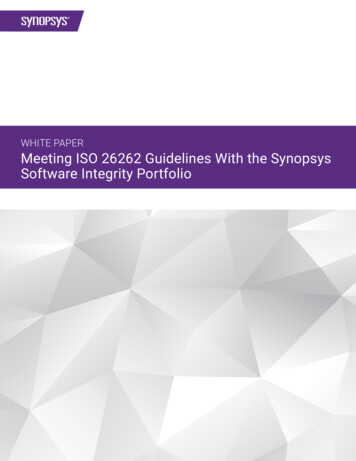
Transcription
WHITE PAPERMeeting ISO 26262 Guidelines With the SynopsysSoftware Integrity Portfolio
Table of contentsIntroduction to ISO 26262. 3Challenges in automotive software development. 3Introduction to the Synopsys Software Integrity Portfolio. 3Applying the Synopsys software integrity portfolio to ISO 26262 requirements. 4General topics for the product development at the software level (ISO 26262:2018, Part 6, Section 5).4Cybersecurity.5Distributed development – Augmenting software integrity requirements within the developmentinterface agreement (DIA).5Tool qualification.6Software modeling and coding guidelines (ISO 26262:2018, Part 6, Section 1).6ISO 26262:2018, Part 6, Table 1: Topics to be covered by modeling and coding guidelines.6Software unit design and implementation (ISO 26262:2018, Part 6, Section 8).7ISO 26262:2012, Part 6, Table 6: Design principles for software unit design and implementation.7Testing of the embedded software (ISO 26262:2018, Part 6, Section 9).8ISO 26262:2012, Part 6, Table 7: Methods for software unit verification.8Testing of the embedded software (ISO 26262:2018, Part 6, Section 11). 10ISO 26262:2018 Table 13: Test environments for conducting the software testing.10ISO 26262:2018 Table 14: Methods for tests of the embedded software.10ISO 26262:2018 Table 15: Methods for deriving test cases for software unit testing.10 synopsys.com 2
The average car is expected to contain 300 million lines of code in the next decade, up from 100 million lines of code in today’scars.1 And software is expected to account for 90% of automobile innovation.2 Software controls everything from safetycritical systems like brakes and power steering, to basic vehicle controls like doors and windows, V2V, V2I, and sophisticatedinfotainment systems and telematics. However, with the exponential growth of software comes a dramatic increase in softwaredefects. The average car is expected to contain up to 150,000 bugs,3 many of which could damage the brand, hurt customersatisfaction and, in the most extreme case, lead to a catastrophic failure. Toyota issued two recalls of its popular Prius model in2018, affecting 2.43 million vehicles, because of a software glitch that caused the cars to stall, increasing the risk of a crash athigh speeds.4 That’s just one example out of dozens since 2000, impacting manufacturers from Alfa Romeo, Fiat, and BMW toFord, GM, and Nissan, and affecting tens of millions of vehicles.5Introduction to ISO 26262To help address vehicle safety, the International Organization for Standardization (ISO) put forth ISO 26262 in 2011 for roadvehicle functional safety. The standard was created to provide guidance to avoid the risk of systematic failures and randomhardware failures through feasible requirements and processes. ISO 26262 is the adaptation of IEC 61508 to comply with needsspecific to the application sector of electric and or electronic elements such as power supplies, sensors and other input devices,data highway, and other communication paths, actuators, and other output devices. The purpose of this paper is to discuss howthe Synopsys software integrity portfolio can be used to help meet the guidelines set forth in ISO 26262.The standard is comprised of 12 parts that span the breadth of the automotive safety lifecycle including management,development, production, operation service, and decommissioning.Challenges in automotive software developmentModern software development environments and practices in the automotive domain are marked by increasing demands foragility, consolidation of functionality, and rapid change. Additionally, with the advent of autonomous vehicles and increasedconnectivity, the spectrum of risk and exposure has broadened.Related challenges that Synopsys has seen across our client base include: Larger, more complex software– Complications for traceability and identification of code re-use, particularly with open source components in first-party andthird-party platforms– Adoption and management of coding standards (e.g. MISRA) at large scale in complex codebases Supply chain and supplier management– Supply chain management of safety and security requirements– Use of qualified tooling during software development Communication reliability and robustness requirements for connected components Management of cybersecurity vulnerabilities during design and after release to production Adoption of qualified tooling for use during developmentIntroduction to the Synopsys Software Integrity PortfolioSynopsys’ software integrity portfolio is designed to help developers, management, and organizations easily find and fix qualityand security problems early in the software development lifecycle, as the code is being written, without impacting time-tomarket, cost, or customer satisfaction.Synopsys solutions augment traditional testing, including quality assurance (QA), functional and performance testing, andsecurity audits, providing development teams with a quick and easy way to test their code for defects and to ensure critical codehas been properly tested in a non-intrusive manner. This enables development to stay focused on innovation, management toget visibility into problems early in the cycle to make better decisions, and organizations to continue to quickly deliver high-qualityproducts to market for competitive advantage. synopsys.com 3
Synopsys provides the industry’s leading development testing portfolio with tailored solutions for development and managementteams that can assist organizations with achieving ISO 26262 compliance.In addition, Coverity Static Analysis is certified by TUV SUD Product Service GmbH according to the applicable requirements ofthe standard IEC 61508 and ISO 26262 for developing and testing safety-critical software.Coverity Static Analysis – Synopsys delivers the industry’s most accurate and comprehensive static analysis solution. It is usedby developers around the world to improve the quality of their code by enabling them to find and fix defects in C/C , Java, andC# code (along with many other languages) faster, which results in lower overall costs. Organizations can create customizedanalysis rules to support their unique requirements through the Coverity Extend Software Development Kit (SDK). Coverity alsoincludes a powerful framework for implementing custom coding policies, named Code XM. Static analysis is included in ISO26262 as a formal verification method for adherence to the coding guidelines and can be used for reviewing pieces of codethat access memory locations containing safety-related data as specified in ISO 26262 Annex D, freedom from interference bysoftware partitioning.Coverity Connect for on-premises deployment – This web portal solution provides a centralized defect management workflowthat enables developers and managers to quickly view defects in the source code and take the appropriate action to resolvethem. Developers and managers can identify defects associated with a particular Automotive Safety Integrity Level (ASIL) andfind where defects occur across various code branches. This capability is a critical time-saver for development teams as codereuse is prevalent in the automotive industry.Coverity Policy Manager – This solution enables organizations to establish and enforce consistent policies tied to safetyrequirements defined in ISO 26262, by ASIL level. It enables users to define clear and comprehensible policies to meet the keyrequirements for this standard. Once the policies have been established, organizations can test against them with CoverityStatic Analysis and quickly visualize areas of risk in the project by component and ASIL level. Managers and executives get ahierarchical view of risk, can understand the relative effort required to address the defect, and can drill down to details to pinpointthe specific issues or verify that specific safety requirements have been satisfied.Black Duck – The Black Duck solution from Synopsys performs software composition analysis (SCA), which enables softwaredevelopers to identify third-party and/or open source components within their existing codebase. A typical HMI system mayencompass hundreds of software packages, many of which originate from open source platforms such as Automotive GradeLinux (AGL) or Android. By utilizing Black Duck’s software composition analysis, a developer may easily discern which packagesare re-use and apply “proven in use” arguments to exclude these from safety scope if appropriate. The additional benefits ofadopting Black Duck in this way also include alerting to software license obligations, as well as security vulnerabilities thatoriginate from open source software packages.Defensics – Fuzz testing, or “fuzzing,” is a method of test case generation and delivery that manipulates normal or expectedinputs in an attempt to trigger failure modes within the target system. Through fuzzing, it is possible to identify crash-causingsoftware defects that may be the root cause of cybersecurity vulnerabilities or safety problems. Defensics is the industry’sonly professional grade fuzz testing tool and is well known for identifying the anomaly that gave rise to the Heartbleed SSLvulnerability in 2014.Consulting services – Through a network of more than 200 consultants worldwide, Synopsys provides expert security servicesto clients across all industries. Within the automotive industry, Synopsys provides Threat And Risk Assessment (TARA) as wellas security validation (penetration testing) engagements. In addition, Synopsys can provide expert strategy consulting to helporganizations develop competencies within their teams.Applying the Synopsys software integrity portfolio to ISO 26262requirementsGeneral topics for the product development at the software level (ISO 26262:2018, Part6, Section 5)Use of continuous integration, and integration of automated toolingThe ISO 26262 standard calls out examples of methods and development approaches that support consistency of developmentactivities and work products. In particular highlighted in Note 1, Example 2 is the role of automated tooling to achieve this goal. synopsys.com 4
All of the Synopsys software integrity tooling detailed in this document are highly amenable to automated invocation, and includeplugins for the most common continuous integration and continuous delivery tools such as Jenkins and Azure DevOps.Organizations seeking to adopt such automation are encouraged to consider the following qualities for Static Analysis withincontinuous integration scenarios: Time taken to process large volumes of code – changes need to be analyzed quickly Ability to run in a fast incremental mode against small changes only Ability to run against partial code changes, rather than the entire codebase Volume of output generated with each small (incremental) change Advanced workflow features for managing the issues identified Alerts when new problems occur in past analysis runs, and automatically generating items on the development team backlogwhen this occursCybersecurityISO 26262:2018 specifically notes that cybersecurity may be considered during the development of embedded software.Synopsys strongly recommends that the topics of cybersecurity, quality, risk, and safety be considered in a unified approach.Many of the tools and methods highlighted in industry cybersecurity standards overlap with the tools and activities thatorganizations typically adopt for safety, quality, and reliability.Although the scope of ISO 26262:2018 relates primarily to functional safety, Synopsys helps organizations carry out a range ofsecurity activities that may generate new safety hazards as defined in Clause 6.4.5 and Annex E of ISO 26262:2018 Part 2: Risk assessment / threat modeling (TARA) carried out during design activities (Appendix E.3.2) Static code analysis to identify coding standards and security vulnerabilities during development (Appendix E.3.3) Identification of robustness failures that may cause security vulnerabilities, via automated fuzzing (Appendix E.3.3) Automated and manual penetration testing at the unit, component, and system level during verification and validation phases(Appendix E.3.3) Identification of open source packages, and ongoing monitoring for new vulnerabilities in third-party open source softwarecomponents (Appendix E.3.4)Synopsys is also involved as a member in formulating the SAE J3061 and ISO 21434 standards, which define comprehensivestrategies for automotive cybersecurity.Distributed development – Augmenting software integrity requirements within thedevelopment interface agreement (DIA)ISO 26262:2018 provides, through Part 8, a number of clauses to specify a development interface agreement (DIA) to facilitateend-to-end collaboration in a distributed development scenario.Typically, Syno
Distributed development – Augmenting software integrity requirements within the development interface agreement (DIA) ISO 26262:2018 provides, through Part 8, a number of clauses to specify a development interface agreement (DIA) to facilitate end-to-end collaboration in a distributed development scenario.


